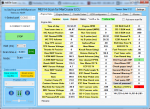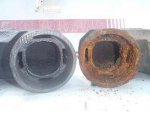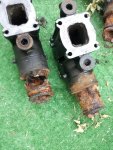jakwi
Petty Officer 2nd Class
- Joined
- Jan 7, 2019
- Messages
- 184
Hi all,
I noticed that there was a little rust on my starboard side exhaust riser joint.
Temps have been normal, 175-180, probably closer to 180.
I can place my hands on both risers and hold them there. Although the Starboard side is hotter, neither is too hot to touch and I didn't notice any hot spots on the risers or manifolds. From what I've read it is normal for the starboard side to be a bit hotter, although I don't understand why. IE after a half hour running down the river I can still place my hands all over the risers, and manifolds without any issues, temps seem uniform.
That being said, I don't know how long it has been since they have been replaced. I was told that the repower had 30 hours on it when I bought it last summer, but without a meter who knows. I flush the motor every time I use it, by running the engine until it's up to temp on Muffs. The previous owner stressed the importance of this to me so I assume he also did this consistently. The boat is used primarily in brackish water. The motor looks good, runs good, my oil is clean, I pulled the plugs and they looked fine, but I replaced them anyway.
The port side has no rust at the gaskets, I haven't pulled it apart yet, but I will.
I know the safe answer is just to replace them, but on the other hand I don't have the money right now. I can start saving for next year, but if I have to replace them right now, then it will sit this summer, That would be a real bummer.
So my question is, how many years do you guys think are on these manifolds/risers and extensions? I've googled about exhaust riser inspections but all you can find for pictures are extreme cases where they are completely shot, I'd love to see some pictures that show what they look like at the 3 year, 4 year, 5 year inspection points, so that I have a point of comparison.
From my point of view the extensions look fine, The manifolds also look pretty good, although the rust inside shows that my gaskets were leaking.
The risers look rustier, but I couldn't find any rot, looks mostly like surface rust with plenty of meat left. I've posted all of the pictures on imgur. The flapper looks droopy, but I don't know if that is normal.
Thoughts? Thanks for the help.
https://imgur.com/a/6i9E7k5
I noticed that there was a little rust on my starboard side exhaust riser joint.
Temps have been normal, 175-180, probably closer to 180.
I can place my hands on both risers and hold them there. Although the Starboard side is hotter, neither is too hot to touch and I didn't notice any hot spots on the risers or manifolds. From what I've read it is normal for the starboard side to be a bit hotter, although I don't understand why. IE after a half hour running down the river I can still place my hands all over the risers, and manifolds without any issues, temps seem uniform.
That being said, I don't know how long it has been since they have been replaced. I was told that the repower had 30 hours on it when I bought it last summer, but without a meter who knows. I flush the motor every time I use it, by running the engine until it's up to temp on Muffs. The previous owner stressed the importance of this to me so I assume he also did this consistently. The boat is used primarily in brackish water. The motor looks good, runs good, my oil is clean, I pulled the plugs and they looked fine, but I replaced them anyway.
The port side has no rust at the gaskets, I haven't pulled it apart yet, but I will.
I know the safe answer is just to replace them, but on the other hand I don't have the money right now. I can start saving for next year, but if I have to replace them right now, then it will sit this summer, That would be a real bummer.
So my question is, how many years do you guys think are on these manifolds/risers and extensions? I've googled about exhaust riser inspections but all you can find for pictures are extreme cases where they are completely shot, I'd love to see some pictures that show what they look like at the 3 year, 4 year, 5 year inspection points, so that I have a point of comparison.
From my point of view the extensions look fine, The manifolds also look pretty good, although the rust inside shows that my gaskets were leaking.
The risers look rustier, but I couldn't find any rot, looks mostly like surface rust with plenty of meat left. I've posted all of the pictures on imgur. The flapper looks droopy, but I don't know if that is normal.
Thoughts? Thanks for the help.
https://imgur.com/a/6i9E7k5






















